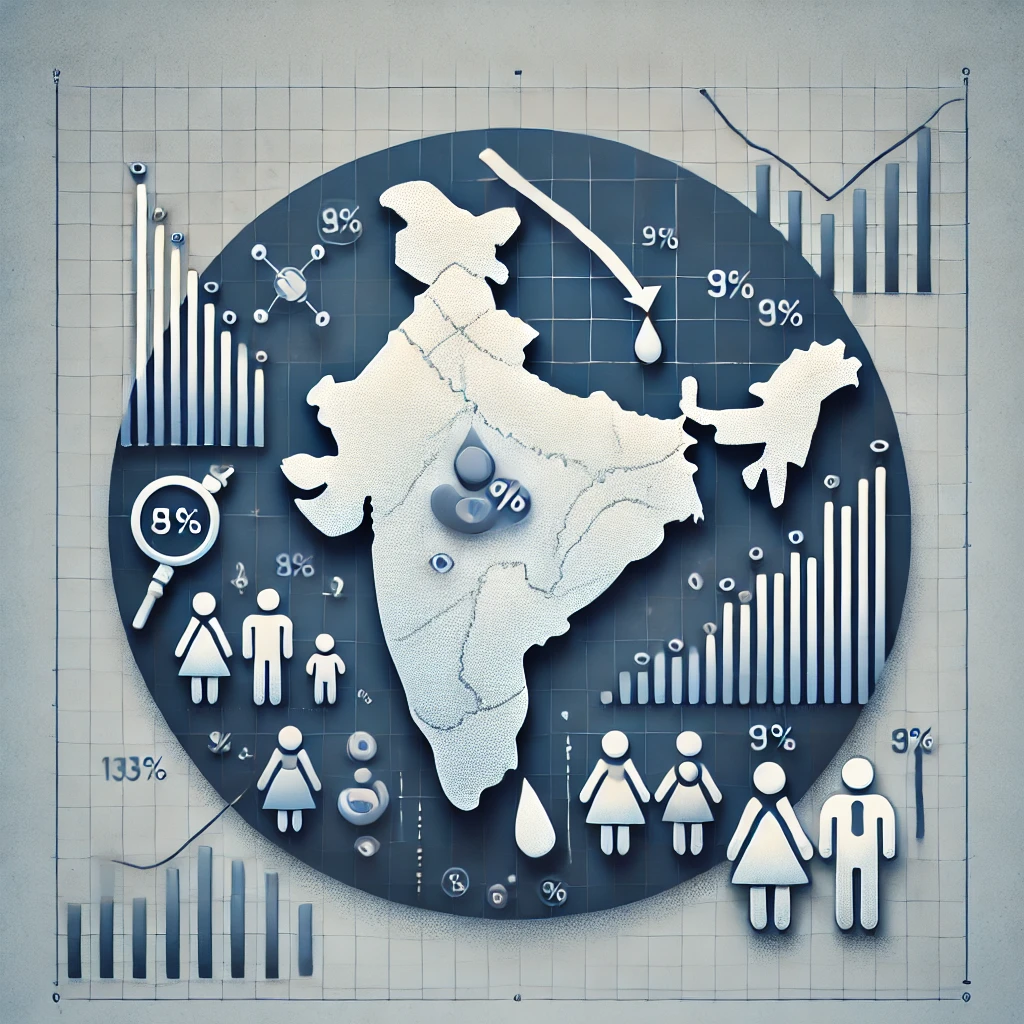Introduction
Fertility rate is a crucial demographic indicator that directly affects a country’s population growth and economic stability. India, with its vast and diverse population, has experienced significant shifts in its fertility rate over the decades. From a high birth rate in the mid-20th century to a steady decline in recent years, India’s fertility trends are shaped by multiple socio-economic and policy-driven factors.
Understanding Fertility Rate
Definition and Measurement
The fertility rate, often measured as the Total Fertility Rate (TFR), refers to the average number of children a woman is expected to have during her reproductive years (15-49 years). A TFR of 2.1 is considered the replacement level, where the population remains stable without external migration.
Also read: Fertility Window: Optimal Time to Conceive & Effective Tracking Methods
Importance of Tracking Fertility Rates
Monitoring fertility rates helps governments plan for population growth, healthcare, education, and economic policies. A declining fertility rate can indicate progress in development but may also lead to future challenges such as an aging workforce and declining labor supply.
Historical Trends in India’s Fertility Rate
Fertility Rate in the 1950s-1980s
India had a high fertility rate of around 5.9 children per woman in the 1950s. The government introduced family planning programs in the 1960s to curb rapid population growth. Despite these efforts, fertility rates remained high due to socio-cultural factors and lack of education.
Declining Trends in Recent Decades
From the 1990s onwards, India’s fertility rate began to decline steadily. Improved access to healthcare, education, and contraception played a crucial role in this reduction. By 2021, India’s TFR had dropped to approximately 2.0, indicating that the population was approaching replacement levels.
Current Fertility Rate in India
Latest Statistics and Data
According to recent government reports, India’s fertility rate stands at 2.0 children per woman. This marks a significant decline from previous decades and reflects changing societal norms and economic conditions.
Comparison with Global Fertility Trends
India’s fertility rate is now lower than some developing countries but still higher than many developed nations where the rate has fallen below 1.5. Countries like Japan and South Korea are experiencing population decline due to extremely low fertility rates.
Factors Influencing Fertility Rate in India
Economic Growth and Urbanization
As India’s economy grows, urbanization increases, leading to lifestyle changes that contribute to lower birth rates. Urban families tend to have fewer children due to high living costs and career aspirations.
Education and Women’s Empowerment
Higher female literacy rates and workforce participation contribute to delayed marriages and fewer children. Women with better education often prioritize career and financial stability before starting a family.
Government Policies and Family Planning Initiatives
India has implemented several policies to control population growth, including birth control measures, sterilization programs, and awareness campaigns on contraception.
Healthcare Advancements
Improved maternal and child healthcare services have reduced infant mortality rates, leading to a lower need for large families as a security measure.
Regional Variations in Fertility Rate
Fertility Rate in Northern vs. Southern States
States in North India, such as Bihar and Uttar Pradesh, have higher fertility rates than South Indian states like Kerala and Tamil Nadu. This disparity is linked to differences in literacy levels, economic conditions, and cultural practices.
Rural vs. Urban Differences
Rural areas tend to have higher fertility rates due to limited access to education and healthcare, whereas urban populations prefer smaller families.
Effects of Declining Fertility Rate
Impact on Population Growth
A lower fertility rate leads to slower population growth, which can ease resource constraints but may also impact economic productivity.
Economic and Social Consequences
With fewer children being born, the working-age population may shrink in the future, affecting industries and economic growth.
Aging Population and Workforce Challenges
A declining fertility rate could lead to an aging population, requiring more healthcare and pension support while reducing the number of young workers in the economy.
Government Policies and Programs
Family Planning Initiatives
The Indian government promotes contraception and reproductive health services through programs like the National Family Welfare Program.
Awareness Campaigns
Educational campaigns on reproductive health and contraception have helped lower fertility rates.
Incentives for Small Families
Some states offer incentives for families with two or fewer children to encourage population control.
Future Projections for India’s Fertility Rate
Predicted Trends
Experts predict that India’s fertility rate may fall below replacement levels in the next two decades, leading to slower population growth.
Challenges and Opportunities
While a declining fertility rate can ease overpopulation concerns, it also poses challenges for economic sustainability. India must balance population control with workforce planning.
Conclusion
India’s fertility rate has declined significantly over the decades due to socio-economic changes, government policies, and improved healthcare. While this trend brings benefits like better resource management, it also presents challenges such as an aging workforce. Future policies should focus on maintaining a sustainable balance between population control and economic stability.
FAQs
1. What is India’s current fertility rate?
India’s current fertility rate is approximately 2.0 children per woman.
2. Why is India’s fertility rate declining?
Factors such as economic growth, education, urbanization, and government policies contribute to the decline.
3. What are the effects of a low fertility rate?
A declining fertility rate can lead to an aging population, workforce shortages, and economic challenges.
4. How does urbanization affect fertility rates?
Urbanization leads to smaller families due to higher living costs and career-oriented lifestyles.
5. What measures has the Indian government taken to control fertility?
The government promotes family planning, contraception, and reproductive health awareness.




